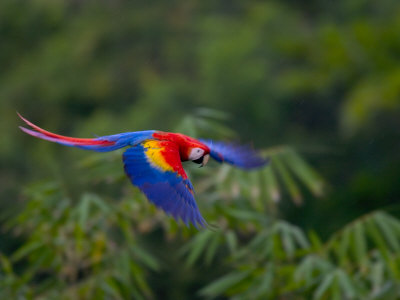The scarlet macaw is one of the world’s largest parrots and, unfortunately, is seriously endangered due to loss of habitat and poaching of chicks for the (now illegal but sizable) pet trade.
These grand birds are very gregarious and you may see them on your Costa Rica vacation (particularly in the southern part of the country and around the Osa Peninsula) as they fly to their nesting sites at night or feeding sites in the morning.
Costa Rica tourism is probably important to their long-term welfare because, with some unfortunate exceptions, the government is committed to sustainable tourism.
Put simply, these birds are worth more as tourist magnets than part of the pet trade.
And, while poachers continue to be a threat to their existence, national laws, treaties and international conventions (CITES) prohibiting transportation and trade of these animals are having positive impacts.
Though you may see them in lowland forests around the Jaco area, Monteverde Cloud Forest Reserve and elsewhere, the best place to see them is at Corcovado National Park on the spectacular but remote Osa Peninsula.

There are about 700 scarlets there, indeed, the largest in all of Central America.
Like to see where it is? Maybe visit on your Costa Rica vacation? Click for comprehensive collection of Costa Rica maps.
Sound like a lot?
Think about it a moment. Once common from Mexico through South America, they’ve been hunted (nests robbed for chicks) nearly to extinction.
Another good spot to see them is at Carara National Park, one of the country’s most popular parks because it’s only about 30 miles west of San Jose.
This is a very good place for Costa Rica birdwatching and because it is so popular you may find other friendly amateur birdwatchers like yourself who are also on their Costa Rica vacation.
You may also see some at Guacalillo Mangrove Reserve.
I’ve seen a pair close to Golfito, a small community in the southern part of Costa Rica and another pair near Jaco along the central Pacific coast.
They’re unmistakable in flight and really a magnificent sight.
Scarlet Macaw Nesting
Macaws typically nest in old or dead trees having cavities high in the tree.
Because of limited number of these holes, there can be great competition, not only from other macaws and parrots but also bees and wasps.
A typical clutch may be four eggs but it’s rare for more than two or three chicks to survive. Hatched featherless and with closed eyes, the chicks remain in the nest until fledgling when they join their parents and other macaws (these are highly sociable birds) in their roosting areas.
Scarlet Macaw Conservation
Though these birds are in serious trouble, there are lots of good people trying to save them.
As a result of reproduction and release programs like Zoo Ave, the Center for Reproduction of Endangered Animals (CRAVE), and the LAPPA conservation association, reintroduction projects have, slowly but surely, helped boost the number of scarlet macaws counted in various studies.
From 1998 through 2007, 86 scarlets were released with a 70% survival rate.
Trying to save a species, one-bird-at-a time.


0 Comment on this Article
Comment closed!